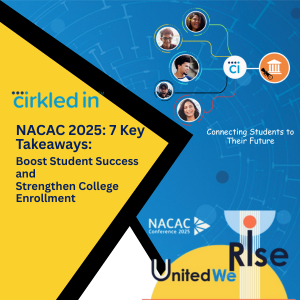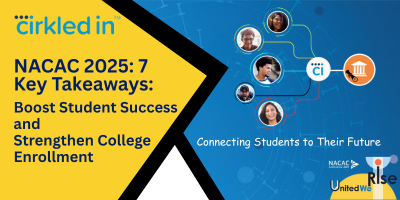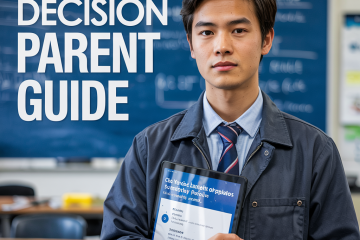NACAC 2025: 7 Key Takeaways to Boost Student Success and Strengthen College Enrollment

At NACAC 2025, one thing was clear: the landscape of readiness and enrollment is evolving. Policies are shifting, students are exploring earlier, and college and career readiness now goes beyond grades — encompassing real-world skills, experiences, and tangible evidence of impact.
High schoolers want personalized guidance, meaningful opportunities, and experiences that align with their interests and aspirations — all while lingering questions about the value of higher education remain in families’ minds. At the same time, colleges are recalibrating admissions strategies, student engagement, and enrollment planning.
Here are seven key takeaways from NACAC 2025 — practical insights for K–12 counselors and higher ed leaders that can truly move the needle.

🏫 K–12 Trends: Preparing Students for College and Career
K–12: Test-Optional Is Being Recalibrated — Portfolios Are Filling the Gap
Test-optional isn’t going away, but admissions teams are increasingly looking for authentic, holistic evidence of readiness — especially for students without scores. Portfolios showcasing leadership, service, research, competitions, and micro-credentials are emerging as high-impact “brag sheets.” They reveal a student’s skills, thinking, and initiative in ways a transcript or test score alone cannot.
- Counselors: Guide students to curate 3–6 “greatest hits” artifacts with brief reflections connecting each piece to academic and career goals.
- Colleges: Invite portfolios and evaluate them using program-specific rubrics to understand fit and potential — creating a fuller story of long-term student success.
K–12: Career Readiness Is a High School Story — Make Skills Visible Through Experiences
High school experiences like internships, volunteering, micro-internships, and passion projects give students clarity about potential majors and career paths— long before they start college. These experiences also produce tangible artifacts that strengthen applications and demonstrate readiness.
- Counselors: Encourage students to take on internships, short-term work, or volunteer experiences. Have them document outcomes and reflect on what they learned.
- Colleges: Invite applicants to showcase skill evidence in portfolios — design projects, code repositories, or business plans. Early alignment with student capabilities supports stronger retention and graduation outcomes, creating a win-win.
K–12: Personalized Guidance & Portfolio Reuse — Brag Sheet as a Compass
Gen-Z and Alpha students respond best to guidance that is relevant, personal, and actionable. The same portfolio or “brag sheet” used for college applications can also serve as a roadmap for high school — guiding internship choices, enrichment programs, mentorship, and career exploration.
- Counselors: Encourage students to treat their portfolio as a living tool for both high school guidance and college prep. Use it to match students with internships, enrichment programs, and mentorship opportunities that align with their interests, skills, and aspirations.
- Colleges: Highlight how portfolios can showcase student fit for programs and scholarships, supporting personalized engagement early and fostering stronger intent.
These high school experiences—portfolios, internships, and personalized guidance—don’t just prepare students for graduation; they also lay the groundwork for successful college applications and meaningful engagement with higher education.
🎓 Higher Ed Trends: Navigating Enrollment and Engagement
Higher Ed: Modest Enrollment Gains Mask Structural Risk
Many colleges celebrated record incoming classes in 2025. It’s a welcome headline, but it can also give a false sense of security. Institutional consolidations, closures, and tuition discounting mean that even a strong year may mask structural challenges.
Headwinds such as the enrollment cliff, student loan policy shifts, immigration rules affecting international enrollment, and ongoing skepticism about the ROI of higher education remain significant. Long-term enrollment health requires looking beyond headcount to revenue, program sustainability, and student outcomes.
- Colleges: Monitor discount rates, and net revenue too. Evaluate institutional health beyond just class size.
- Counselors: Advise families to consider institutional stability, financial health, and degree completion pathways early in the search.
Higher Ed: International Enrollment Is Softening — Overdrive Domestic Pipeline
Many campuses reported flat or declining international enrollment in 2025, with overall numbers down roughly 15% compared with last year. Visa backlogs, geopolitical uncertainty, and tighter work pathways have contributed to a soft market (read our previous article on Impacts of H1B Fee Hike on College Enrollment). Relying on few international sources is no longer enough — a robust domestic strategy is essential.
- Colleges: Diversify international recruitment beyond a few dominant countries and double down on domestic pipelines. Focus on micro-segmentation, early opt-in engagement, and personalized outreach to attract Gen-Z and Alpha students.
- Counselors: Highlight institutions that combine experiential learning with realistic career outcomes for international students — without over-promising post-study work opportunities.
Higher Ed: Earlier, In-Context Engagement Wins
One theme echoed in hallway conversations: the colleges that win are the ones “students grow up hearing about”. Students explore internships, part time jobs, scholarships, and various majors long before they create a formal college list.
Engaging students in these early moments builds familiarity, trust, and a deeper understanding of your programs. It shifts the relationship from transactional (“apply now”) to relational (“we understand who you are and what you want”). Early engagement helps students understand programs, fit, and outcomes — laying the foundation for stronger yield and long-term success.
- Colleges: Place program stories, events, and RFIs inside the student journey when they are actively exploring options — not just on your website. Use personalized, context-driven outreach to nurture interest early.
- Counselors: Direct students to platforms and experiences that allow them to discover colleges organically, explore programs, and showcase their work or skills.
Higher Ed & K–12: Direct-Admit at Scale Creates Noise — Focus on Intentional Engagement
The direct-admit movement promised frictionless access, but at scale, it’s creating new headaches. Students are flooded with multiple, indistinguishable offers, leading to choice paralysis and diluting perceived program value. Yields often remain uncertain because many “admits” were never true prospects.
What’s working better: brand-ambassador style presence where students engage in context – exploring internships, scholarships, and programs. When a college shows up in-context with program stories, outcomes, and next-step nudges, the signal cuts through the noise, and interest is earned through opt-in engagement, not assumed by default.
- Colleges: Shift focus from mass direct-admit campaigns to targeted, in-platform, opt-in discovery. Use tight RFIs and next-step nudges to cultivate genuine interest and improve yield quality.
- Counselors: Help students weigh fit and outcomes thoughtfully, rather than counting offers. Guide them to consider where they can thrive academically and personally.
🤖 Shared Trend: AI Is Useful — But Only with Guardrails
AI is increasingly supporting communications, triage, and content review in both K–12 and higher education settings. But over-automation can backfire: generic responses, opaque scoring, and privacy gaps quickly erode trust. Effective teams combine AI with human oversight, clear disclosures, and robust checks for bias or errors.
- Colleges: Keep humans in the loop for admissions, aid, and communications. Audit AI for bias and hallucinations, and accuracy. Be transparent about AI use and never compromise consent for speed.
- Counselors: Use AI to scale reminders, resources, and research support — but maintain personal relationships. Keep sensitive student data off experimental tools.
- Students & Families: Expect faster answers, but verify important information and manage your consent settings carefully.
✍️ Final Thoughts
As NACAC 2025 highlighted, the landscape of college and career readiness is evolving rapidly. Holistic evidence, authentic engagement, and early, personalized relationships are shaping the future of college admissions and career readiness.
Students thrive when their skills and achievements are visible; colleges succeed when they engage authentically and strategically. Portfolios, internships, and personalized guidance are no longer optional — they are the foundation for readiness and success outcomes for both students and colleges.
By emphasizing intentional engagement and thoughtful use of technology, counselors and higher education leaders can guide students more effectively and build stronger, lasting connections.
Institutions and advisors who adapt thoughtfully — balancing innovation with human insight — will be best positioned to help students succeed and flourish in the years ahead.
About Cirkled In:
Cirkled In helps colleges and universities engage and recruit students more effectively by providing access to high-quality prospect data, targeted hand-raiser inquiries, and actionable insights into student interests and pathways. Our platform supports enrollment leaders in building diverse and robust pipelines, connecting with students both domestically and internationally, and optimizing recruitment strategies for today’s competitive higher education landscape.



32 Comments
mandy dillon · October 25, 2025 at 7:34 am
nothing
Amy S · October 27, 2025 at 10:41 am
We’ll take “nothing” as “no notes, it’s perfect” 😎 Thanks for reading, Mandy!
Liana Brooks · October 29, 2025 at 1:24 pm
Good
Amy S · November 3, 2025 at 11:30 am
Appreciate it! Hope the takeaways sparked a few ideas for your next enrollment season!
Lashay Freese · November 3, 2025 at 6:35 pm
It is in point of fact a great and helpful piece of info. I’m satisfied that you shared this useful info
with us. Please stay us up to date like this.
Thank you for sharing.
Hassan Echevarria · November 3, 2025 at 7:23 pm
Keep on working, great job!
Allen Heyward · November 4, 2025 at 12:40 am
Aw, this was an incredibly good post. Spending some time and
actual effort to create a really good article… but what can I say… I put things off a lot and don’t manage to get
anything done.
Javier Gadsden · November 4, 2025 at 11:40 am
I think everything published made a ton of sense. But, what about this?
suppose you were to write a killer title? I ain’t saying your content is not solid., but suppose you added
a post title that makes people want more? I mean NACAC 2025:
7 Key Takeaways to Boost Student Success and Strengthen College Enrollment – Cirkled In is kinda plain. You might peek at
Yahoo’s front page and note how they create article
headlines to grab viewers to open the links. You might try adding a video or
a pic or two to get readers excited about everything’ve got to say.
Just my opinion, it might bring your blog a little livelier.
Star Larenner · November 5, 2025 at 12:26 am
Tremendous issues here. I’m very satisfied to see your post.
Thanks a lot and I am having a look ahead to touch you.
Will you kindly drop me a e-mail?
Dustman · November 5, 2025 at 5:12 pm
Finally, something worth reading. It’s great to find postings like this one.
Bob Phipps · November 6, 2025 at 10:48 am
I couldn’t resist commenting. Perfectly written!
Colleen Flower · November 7, 2025 at 8:34 pm
I believe that is among the most significant info
for me. And i’m satisfied studying your article. But want to
remark on some general things, The website style is great, the
articles is in point of fact excellent :
D. Good activity, cheers
Stacey Bisson · November 8, 2025 at 8:09 pm
Good day! I could have sworn I’ve been to this web
site before but after going through some of the articles I realized it’s new to
me. Regardless, I’m definitely happy I came across
it and I’ll be book-marking it and checking back regularly!
Carmela Scutt · November 9, 2025 at 2:31 am
Thanks for finally talking about > NACAC 2025: 7 Key Takeaways to Boost
Student Success and Strengthen College Enrollment – Cirkled In < Liked it!
Aurora Quinonez · November 9, 2025 at 8:34 am
Excellent pieces. Keep posting such kind of info
on your page. Im really impressed by your site.
Hello there, You’ve done an incredible job. I will definitely digg it and
in my view recommend to my friends. I am confident they’ll be benefited from this web
site.
Krystyna Knapp · November 9, 2025 at 6:06 pm
Hi, I check your blog regularly. Your humoristic style is awesome, keep up the good work!
Francisca Bounds · November 9, 2025 at 11:09 pm
I love what you guys are usually up too. Such clever work
and reporting! Keep up the terrific works guys I’ve included you
guys to my blogroll.
Carma Stopford · November 10, 2025 at 10:43 am
Your method of describing everything in this post is truly nice,
all can easily be aware of it, Thanks a lot.
Amy S · November 10, 2025 at 1:17 pm
Appreciate that! 😊 We’re all about turning big insights into “aha!” moments—glad it clicked for you!
Amy S · November 10, 2025 at 1:18 pm
Thanks a ton for the kind words, Francisca! 🙌 We’re thrilled to be on your blogroll — glad you enjoyed the read and found it worth sharing! 💪📚
Amy S · November 10, 2025 at 1:20 pm
Thanks for reading and cheering us on, Krystyna — more posts (and puns) coming your way soon!
Amy S · November 10, 2025 at 1:24 pm
Aw, you just made our day, Aurora! 🙌 Thanks for the kind words and for spreading the word — we’re all about helping students (and educators!) thrive. Stay tuned for more!
Amy S · November 10, 2025 at 1:25 pm
Appreciate the love, Carmela! ❤️ Here’s to making student success and college enrollment smarter, one takeaway at a time.
Amy S · November 10, 2025 at 1:26 pm
Hey there, Stacey! 🌟 It’s always fun discovering new corners of the internet—even if it feels familiar! We’re thrilled you found us and can’t wait to share more insights with you. Happy bookmarking! 📚
Amy S · November 10, 2025 at 1:28 pm
Thanks so much, Colleen! 😊 We’re thrilled you found it helpful. Glad you liked the style too — we try to keep things both useful and easy on the eyes! 👀
Amy S · November 10, 2025 at 1:32 pm
Thanks so much, Bob! 🙌 We’re thrilled it resonated with you. Here’s to helping students succeed and making enrollment a little smoother!
Amy S · November 10, 2025 at 1:34 pm
Appreciate the love! 💡 Nothing makes us happier than sharing content that actually helps. Cheers to smarter enrollment strategies!
Amy S · November 10, 2025 at 1:37 pm
Thanks so much for the kind words! 😊 We’re thrilled the post resonated with you. Feel free to drop us an email anytime — we’d love to continue the conversation! ✉️
Amy S · November 10, 2025 at 1:40 pm
Really appreciate you taking the time to share your thoughts, Javier! 😊 Headlines and visuals can totally make a post pop, and we’ll keep experimenting with ways to grab attention. So glad you found the content helpful—your feedback made our day! ✨
Amy S · November 10, 2025 at 1:41 pm
So glad you enjoyed it, Allen! 🙌 Putting things off is human, but every bit of effort adds up. Start small, and watch it snowball! ❄️✨
Amy S · November 10, 2025 at 1:42 pm
Thanks so much, Hassan! We’ll keep the insights coming 🚀 Your support keeps us going!
Amy S · November 10, 2025 at 1:43 pm
Thanks so much, Lashay! 🙌 We love sharing insights that actually help. Stay tuned — there’s plenty more to come!
Comments are closed.